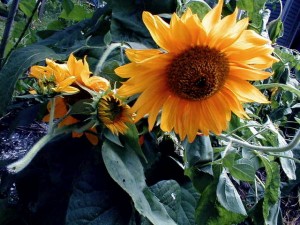My interest in saving seeds began with sunflowers. More than a decade back, we decided to fill the middle of the large round bed in our garden with sunflowers. Jim’s Grandma McGregor always had wonderful sunflowers in her garden so the blossoms remind both of us of her. We purchased four different varieties of seeds, which eventually filled the center of our garden with amazingly tall, sturdy and bright sunflowers.
At the end of the season, Jim harvested a dozen sunflower heads and brought them into the house to finish drying. When I asked if he were going to feed the birds later, he explained that he was planning to save the seeds.
The next summer, we planted a completely free sunflower bed, and the blooms were even prettier at that cost.
Seeds are not really all that expensive, however, saving seeds is an easy and satisfying way to step up one’s gardening practice. Saving seeds requires only a little knowledge and planning. More advanced resources are available in books and on the web, such as the group Seed Savers, but here’s a quick introduction to some easy seeds to save and a run-down on seed saving practices.
Sunflowers are fun to grow, and their seeds are very easy to save. In our neighborhood, the squirrels are extra vigilant in monitoring the area for edibles so in late summer we have to keep a close eye on our sunflowers too. When the heads are nearly spent and the seeds have formed, we cut them off and bring them into the house to finish drying. Once the heads have dried completely, the seeds can be very easy removed and stored.
Green beans are another seed that is easy to save. You can either allow some beans to remain on the plant past the best eating stage (the still-straight, not yet bumpy stage) or late in the season, look for the beans that you missed as you are taking down the plants. That worked for me. Select pods with many beans where the outside skin is dry or almost dry. Take these indoors and spread them out on a tray to finish drying. Then break open the pods and store the seeds.
Chives and garlic chives are another plant that makes saving seed easy. We wait until the end of the season, after plants have gone to flower and the flowers have dried. Watch for when the heads begin to open, and you’ll see the small round black seeds inside. You can snip off the heads with scissors and bring them indoors to finish drying. Shake the seeds out of the dry heads and store.
For the best outcome, store seeds that you harvest in a cool, dark place with little moisture. You can use jars if you wish. We’ve also used envelopes. Make sure to label and date your seeds.
Two words of warning require a little bit of plant knowledge to understand.
Hybrid seeds are probably not worth saving. Hybrid seeds have been crossbred for some particular aspect of the plant, like large fruit or all fruit ripening at the same time. The next generation of a hybrid seed may not germinate at all or the result could be significantly different than the plant it came from. The alternative to hybrid is open-pollinated or heirloom varieties. Seeds from reputable companies are clearly labeled. You can also ask when purchasing seeds or sets for your garden.
Another warning involves the cucurbit family, which includes squash, melons, pumpkins, and gourds. These plants are easily cross-pollinated while growing in the garden; in fact, they are sometimes described as being promiscuous. The cucumber plant you planted will produce true cucumbers perfectly fine when the bees mix its pollen with, say, a watermelon’s, but the resulting seeds inside the cucumber will be a watermelon/cucumber cross. There’s no telling what would result from that seed until it is grown. In 99% of the cases, it will be a disappointment.
There are ways around this dilemma, but they aren’t simple. One is to grow only one kind of cucurbit within a 1/4 mile radius. The other involves covering the blossoms and making sure that random cross-pollination does not occur. Both of those strategies are beyond my gardening abilities at the present time.
Many other seeds from vegetables and flowers can be saved by gardeners for future planting. These are just a few that we’ve had success with. I want to try saving tomato and pepper seeds, and maybe I’ll give that a try next year.
Have you had success with seed saving? What tips would you give to a beginning seed saver?





2 Responses
Stay in touch with the conversation, subscribe to the RSS feed for comments on this post.
Continuing the Discussion